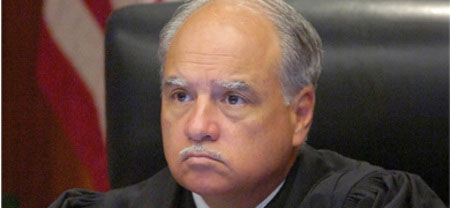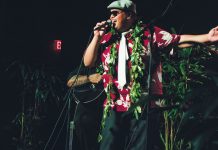Sky Barnhart, Jill Engledow, Michael Stein, Matthew Thayer, Paul Wood, Jon Woodhouse | Photography by Amanda Cowan | Jason Moore | Tony Novak-Clifford
Doctor, lawyer, activist, judge, educator, comedienne . . . there’s something about Maui that attracts individuals who move to the beat of a different drummer. Of our ten, some are public servants whose accomplishments you may want to cheer or boo. Others stand up to the system and say it has to change—or find the courage to stand before an audience and try to make us smile. And while most of them could walk unrecognized down any Main Street USA, they have this in common: a passion for what they think is right for Maui County—whether others agree or not.
 Joseph Cardoza
Joseph Cardoza
Man on the Bench
Second Circuit Court Judge Joseph Cardoza reminds you of a small-town judge in an old Hollywood movie.
His character wouldn’t be the cranky, imperious justice who rules the courtroom with an iron fist, nor would he be the buffoon who has no clue of what is going on as smart lawyers bulldoze the law.
No, Cardoza’s character would be the soft-spoken, honest man who finds himself in the middle of a legal maelstrom as big business squares off against the little guy. Working in the same town where he grew up, he wrestles with contentious hearings all day, then laces up his cleats to referee high school football games at night. As political pressure builds from the state capital, he weighs issues carefully before making his decision solely on the basis of law.
It was no movie, but at times last year it sure seemed like it, as the legal wrangling over the Hawai‘i Superferry took center stage in Cardoza’s Wailuku courtroom.
The drama began in early 2007 when Cardoza ruled against environmental groups trying to block the Superferry from starting service between O‘ahu and Maui. The large, fast interisland ferry had become a target for Neighbor Islanders who opposed it for a litany of reasons. Riding the full support of Hawai‘i Governor Linda Lingle, however, the ferry had sailed through all opposition. Cardoza’s ruling appeared to clear away the last hurdle.
And then in August, just days before the ferry was scheduled to begin service to Kahului Harbor, the Hawai‘i Supreme Court ruled the state was wrong to waive an environmental impact assessment, since state funds were being used for Superferry upgrades at Maui’s only deep-draft harbor. The whole controversy was plopped back in Cardoza’s lap.
He ended up refereeing a month of sometimes contentious hearings. With high-powered ferry and state attorneys on one side of his courtroom, and veteran advocate Isaac Hall on the other, Cardoza handled the high-profile case as if it was second nature. He remained steady and calm and demanded civility from all involved. In spite of dealing with a busy docket, the death of his father, and his duties as one of Maui’s top football officials, Cardoza spent long hours preparing himself for the case. His rulings were decisive. Not once did he seem surprised or caught off guard.
Exhibiting a flair for drama, or perhaps a desire for calm in his packed courtroom, Cardoza kept everyone on the edge of their seats before making his final ruling. For a full hour, and without giving an indication which way he would side, he explained the basis of his decision. He asked both sides to show respect and courtesy to each other.
In the face of intense political pressure, Cardoza ruled for Maui Tomorrow, the Sierra Club and the Kahului Harbor Coalition. He issued a temporary restraining order, requiring an EIS before the Superferry could dock on Maui.
Governor Lingle then called a special session of the Legislature to draft a bill allowing the Superferry to operate while the EIS was being done. Lingle signed the bill into law in November. Attorneys once again assembled in Cardoza’s courtroom where he followed the new law and lifted the ban on the Superferry. He later ruled that Superferry officials must pay their opponents’ legal fees.
Short of stature and unassuming in appearance, Judge Joe Cardoza stood tall in the middle of one of the island’s epic legal frays. Keeping personal feelings, political considerations and public opinion out of the mix, he let the law guide him—just like in a Hollywood movie.
—Matthew Thayer
Mick Fleetwood
Rumor Has It
Ever since he landed on this island in 1973, British rock legend Mick Fleetwood dreamt of making Maui his home. He finally settled on our shores in 2006, and soon set about drawing some of our finest talent into his creative vortex. At last summer’s Crater Festival in Honolulu, he launched Mick Fleetwood’s Island Rumours Band to jubilant acclaim.
Fleetwood now ponders recording this novel project, and even contemplates reprising the Blue Max—Lahaina’s famed but long-departed music hot spot.
So what inspired a member of Britain’s rock elite to settle on Maui, and begin working with local musicians, incorporating Hawaiian music into his remarkable legacy?
“I knew when I first came here that, after the madness calmed down, this was where I wanted to be,” Fleetwood explains. “In the early years I used to arrive in pieces from the lifestyle I was leading. I was drinking a hell of a lot and the party was forever. I came here to heal myself. Maui was where I turned around.”
A co-founder of Fleetwood Mac, one of the world’s most successful rock bands, the venerable drummer has long pursued diverse creative avenues, including traveling to Ghana in 1981 to produce The Visitor with African musicians.
Once he was firmly ensconced on Maui, it was natural for him to reach out to our musical community. “Mick, musician, loves to play, wants to play,” Fleetwood continues. “I made a conscious effort to connect with people from the island that have a real awareness of the culture.”
Blending blues, rock and Hawaiiana, the Island Rumours Band is an electrifying ensemble that combines the talents of the Hoku Award-winning Barefoot Natives (Maui natives Willie K and Eric Gilliom), Moloka‘i’s Grammy-nominated falsetto singer Raiatea Helm, former Fleetwood Mac guitarist Rick Vito, percussionist Lopaka Colon from Henry Kapono’s Wild Hawaiian band, and bassist Lenny Castellanos—all anchored by Fleetwood’s towering, powerhouse drumming.
Having worked with some extraordinary musicians over the years, from guitar legend Peter Green to creative genius Lindsey Buckingham, Fleetwood sought talented musicians who could comfortably gel and reflect a dynamic presence.
“When I saw Raiatea . . . without doing anything she had such a charming joy about her presence. Then in terms of a tornado effect, there’s Willie K, who is incredibly multitalented. I know what’s going to make things magic and it’s chemistry, and that comes from the vibration that people exude.”
Later in the year, Fleetwood hopes his new band will create magic in the studio. “I so want to record this band and I believe we’re getting close. With a great reservoir of people, music will always be able to happen—like a Traveling Willburys thing,” he adds, referring to the brief but dynamic collaboration of George Harrison, Bob Dylan, Roy Orbison, Tom Petty and Jeff Lynne. “I hope . . . to be learning and having rapport with some great players here.”
Fleetwood’s dreams include establishing a new, comfortable venue like Lahaina’s old Blue Max, where he could jam with visiting mates.
“I’m not coming here to retire,” he concludes. “I know the combo of being active musically and having . . . something that’s alive. That would be my pipe dream—to have a really great place to go that’s mine [where] I can invite people down to come and play.”
—Jon Woodhouse
Ron Kwon
The Doctor is Out
Ron Kwon says he couldn’t take the pain anymore, watching patients suffer in the health-care system this Maui-born M.D. spent two decades of his life trying to improve. After his efforts to build a new hospital were blocked by state rules, Kwon and his wife, Sue, sadly decided to leave Maui.
“I’m sixty-one years old,” Kwon said before his departure in April for a new position in Massachusetts. “I’ve got about ten more years of good work ahead of me.”
The Kwons are starting over where Ron began his career. After growing up in Pu‘unene, he attended Harvard and the University of Colorado College of Medicine, did his residency at Tufts-New England Medical Center in Boston, then practiced internal medicine at Emerson Hospital in Concord, Massachusetts. He spent seven years on staff in a hospital that “always prided itself on getting better,” Kwon says. “The people in that community love that hospital. I got spoiled. I thought all community hospitals were like Emerson.”
In the 1980s, with his parents growing older, Kwon decided to come home. His father warned him it would be “the worst career move you’ve made.” Within six months, Kwon agreed. He says that, under state control, Maui Memorial Hospital (now Maui Memorial Medical Center) was old, overcrowded, and behind the times in equipment and training.
“I spent the next ten or twelve years working with others to make things better. We made noise; we fought,” Kwon says, and there were changes. But in 1996, the Legislature turned over hospital control to the Hawai‘i Health Systems Corporation, a quasi-public system “not responsible to private or public.” Kwon decided real improvement was unlikely and began work to establish a private hospital. As board chairman of Malulani Health Systems, he gathered hundreds of enthusiastic supporters for a proposed state-of-the-art $200 million hospital on a forty-acre parcel in South Maui. Despite the support, Malulani was refused the state’s Certificate of Need required for establishment of a new medical facility.
Back in Massachusetts, former colleagues had been following the situation from afar, and asked Kwon to come help them implement some of the progressive ideas he had proposed for Malulani.
Where does this leave efforts to create a new hospital on Maui? “I don’t know where we go from here,” says former Malulani board member Judy McCorkle. “Ron has tremendously raised the awareness of the state of health care on Maui. I still think we need a new hospital. Putting more money into an aging structure is not the best use of our resources. Hopefully, better health care is an idea whose time has come.”
he conversation continues, led in part by the Association for Improved Healthcare on Maui, whose spokesperson, Jan Shields, says Kwon’s efforts inspired AIHM’s formation. “Dr. Kwon is intelligent, courageous, and a true humanitarian,” Shields said. “Maui will never forget Dr. Kwon.”
—Jill Engledow
Nora Burns
Manhattan Mama
Standing in the spotlight of the McCoy Studio Theater stage, dressed in black, Nora Burns spills out her confession. “I’m doing well in real estate, but I keep having artistic urges,” she tells the audience guiltily. “I had the house in Kula, the charge account at Macy’s; then I read The Artist’s Way and I became convinced I had a creative gift and I owed it to myself and the public to express it. . . . I ended up naked, covered in chocolate, screaming haikus and gathering found objects.”
At this moment, Burns is playing a newcomer at an Artists Anonymous meeting. But in the next moment, she’s likely to be someone else entirely: a crass border-town housewife, an indecisive latte buyer, a poster girl for a new feminine product.
Once she gets on stage, there’s no telling where this talented comedian will go. All we know is, she won’t go there alone. Burns has a passion for bringing other avant-garde comedy artists like herself to Maui. Originally from New York, Burns is the island’s “Manhattan Mama,” serving as a link between the hip, funky comedy clubs of the mainland and the little theater at the Maui Arts & Cultural Center.
She founded Manhattan Mama’s Coconut Cabaret in March 2006 as a home for “the more offbeat stuff you’d see in public theater or weird little nightclubs—the cabaret acts, the different and unusual performers that people just don’t see here.” The McCoy provides a perfect venue for the monthly shows: dark and intimate, yet big enough to accommodate a crowd—and their glasses of merlot, giving it a nightclub feel.
Throughout the season, Burns hustles in needy drag queens, burlesque acrobats, overwrought yoga-philes and more. Most of the acts are adult oriented, usually containing risqué material or language. “This is not the stuff you’d see at the Laugh Factory; it’s not ha-ha-ha!” she says. “It’s funny, but it’s more thoughtful performance humor.”
Burns seeks out the acts during frequent trips to New York and Los Angeles. During her fifteen years in alternative comedy, she has performed in countless clubs with top-level artists coast to coast. (Back in the day, she and Margaret Cho performed at the same venue in Provincetown, Rhode Island; Cho remembers her as being “very, very funny.”) Burns jokes that she got her degree in “nightclubbing” along with her degree in English from Columbia University.
She loves the freedom of sketch comedy, creating her own characters from real-life inspiration or pure imagination. “When you have a new piece, you have no idea how it’s going to go,” she says. “You fall flat on your face sometimes.” But the Maui audience is always appreciative. “Unlike the big cities, where the audience might be jaded, Maui has a great audience,” she says. “If they come, they’re ready to go along for the ride.”
It’s getting them into the theater that can be the tough part. “People don’t move to Maui or live here because they want to see cutting-edge theater,” Burns says. Still, she plans to persist in her one-woman, multipersona crusade to ensure that Maui gets that titillating taste of Manhattan.
For more information, visit www.neocomedy.com.
—Sky Barnhart
Charlie Jencks
The Best-laid Plans . . .
Charlie Jencks was a popular guy to talk to when he was Maui County’s director of Public Works.
It seemed he couldn’t go anywhere on the island without someone coming up to ask when their street would be repaved, why their garbage wasn’t picked up, or to tell him what was wrong with this or that service. In 1998, after six years as director for two different mayors, Jencks stepped away from public life and, he hoped, into a bit of obscurity.
Lately, however, he’s back on the hot seat. As the owners’ representative for the controversial development Honua‘ula, Jencks finds himself once again a magnet for conversation. Whether he is at the grocery store or a Boy Scout meeting, he often gets an earful of opinions, some supportive and some negative.
The 670-acre project, formerly called Wailea 670, has divided opinion across the island. Some residents see it as good for jobs, housing and the economy, while others express concern about its impact on Maui’s rapid growth. Jencks says he welcomes the dialogue.
“If I didn’t feel like I was doing the right thing here, I wouldn’t be doing it,” Jencks says. “I’ll talk to people any time of the day about it, and it happens a lot.”
Jencks credits his experience as Public Works director for Mayors Linda Lingle and James “Kimo” Apana for giving him insight into what Maui needs. He also draws on his leadership roles with the Maui Family YMCA board, Maui County Council Boy Scouts of America, Maui Contractors Association, Maui Chamber of Commerce and the Seabury Hall Board of Directors.
“I felt from the beginning my experience as director of Public Works gave me a good handle on what is going on in Maui County. When Steve Goodfellow asked me to do this project, I was not only helping a friend, but I felt like I could create something that would benefit South Maui and Maui as a whole.”
Jencks became aware of the property that runs from Maui Meadows to the Wailea-M¯akena border when his former father-in-law, Karl Bergheer, bought it in 1986. That was the same year Jencks moved to Maui to help Bergheer develop the Grand Champions Villas in Wailea.
More than twenty years and quite a few contentious hearings later, Honua‘ula appears close to approval. A committee vote by the Maui County Council showed that, as of press time, it would likely have the support needed to pass this spring.
The project is set to provide 1,150 housing units on site and another 250 units in north K¯ihei. It includes 40 percent single-family and 60 percent multifamily, with 450 units earmarked as “affordable.”
Jencks says that while he has heard his share of negative comments, he believes Maui needs more housing.
“There are so many people who come up me and say, ‘We need a place to live. We need affordable housing. Keep going. Don’t stop.’ I’ve spent a lot of time with the folks in the trades and in the unions. The guys are working their butts off and they want a place to own, a place to live.”
Jencks is married to wife Ilsa. His son, Peter, attends college in California.
—Matthew Thayer
Linda Lingle
Executive Decision
Governor Linda Lingle has often surprised people with her sturdiness and straightforward manner. These traits, plus an incisive intelligence when it comes to bipartisan compromise-building, have helped her put together a remarkable life of public service as a Republican in a virtually one-party Democratic state.
But this year Governor Lingle found her judgment on certain key issues questioned. Many longtime allies on Maui and Kaua‘i feel that they’re dealing with a governor they hardly know anymore.
This was the woman who came from St. Louis and founded The Moloka‘i Free Press. She became a Maui County Council member and then a two-term Maui County mayor. Her achievements on Maui, where she gained high marks for performance-based budgeting and stimulating job growth, helped propel her to higher office—as Hawai‘i’s first female governor.
Now former allies have accused her of “O‘ahu-centrism.” They wonder how she could propose buying Turtle Bay, on O‘ahu’s North Shore, to keep it from development, while not protecting Moloka‘i’s La‘au Point, and not working harder to bring a second hospital to Maui. Above all, they denounce her unstinting support of the Hawai‘i Superferry, opposed by thousands on Maui and Kaua‘i because of concerns ranging from invasive species threats to danger to migrating whales.
Lingle says she has no regrets about spearheading Act 2 through the state Legislature to allow “an Inter-Island Ferry Service” to continue operation while an Environmental Impact Assessment is being done. “I’m focused on making sure the Superferry succeeds. We won’t have an opportunity again for this kind of transportation alternative for the Neighbor Islands.” She feels the majority on Maui and Kaua‘i are for the Superferry.
Pointing out how she once convinced the federal Public Benefit Guarantee Corporation to take over Aloha Airlines’ pension fund to help preserve the airline, she insists she made no exception in the case of Superferry. “It’s not about helping a company, but maintaining transportation choices for people.”
And she has no regrets about convincing the state Legislature to, in effect, override Second Circuit Court Judge Joseph Cardoza’s order that would have suspended Superferry operations, pending completion of an EIS. “The judiciary is there to interpret the laws. They don’t decide how we live our lives. People elect legislatures, and our option is to change the laws. This was the exactly appropriate thing to do.”
As always, the governor has tried to build bridges. She met with everyone from the Pacific Whale Foundation to Maui Tomorrow to develop forty new operating conditions for the Superferry to safeguard the environment.
Lingle remains serenely confident of her choices, and she’s determined to use the rest of her term to preserve a range of choices for Hawai‘i’s people. She supports the Moloka‘i Master Land Use Plan as “a once-in-a-generation opportunity for the people of Moloka‘i to determine their own destiny.” She’d like to see another hospital on Maui, but thinks Maui voters have to push their legislators to have the issue actually get a hearing. Above all, she relishes the chance for direct action on issues that range from increasing Hawai‘i’s energy independence, to moving the economy away from overreliance on development and towards health care and new technology.
“This is a tremendously satisfying job. For example, I can see homelessness and do something about it. I can declare an emergency, bypass certain laws, get things done more quickly.” It’s a difficult balancing act to perform, but no one can accuse Governor Lingle of not wanting to get on the wire.
—Michael Stein
Rene Yamafuji
Artistic Principal
She’d spent a decade as principal of Kula Elementary, a successful public school with a hard-working faculty and a supportive parent organization. And yet, last January, when the Department of Education started searching for a principal to launch its brand-new school in Central Maui, Rene Yamafuji scheduled an interview. Two weeks later she was the head of Pomaika‘i Elementary, a school with no pencils, no trash cans, no teachers, no students, no traditions, and a six-month deadline to get it together.
Why would someone leave such a solidly established position for the giddy turbulence and potential chaos of starting from scratch? “I wanted to make learning fun again,” says Rene—which rhymes with “green.”
And she said as much in her interview. “I said it was time to have more arts in the classroom, not just math and testing, math and testing. The arts are not just a frill. They are an important part of education, vital to educating the whole child.”
By “the arts” she means much more than cutting out paper turkeys for Thanksgiving. She means “arts integration,” a growing national trend of reforming education through innovative teaching methods—methods adapted from drama, dance, music, visual art, and creative writing. For example, schoolteachers are discovering that theater games (normally used to train actors) boost literacy levels by having students act out stories and ideas. That’s why Rene contracted with Maui Academy of the Performing Arts (MAPA) to work in Pomaika‘i classrooms, showing her teachers how to use tableaus to teach reading skills.
“Sometimes arts integration comes across in little things,” she says. “I was reading a book to some kindergarten students, and the character felt surprised. I said to the children, ‘What does surprise look like?’” With big, comical expressions, each student showed a personal understanding not only of the meaning of the sentence but also the feelings of the character.
“They also learn social skills this way. In drama you need to cooperate.”
Rene never thought about arts integration before taking the post at Kula School and noticing that some of her teachers had attended workshops through the Maui Arts & Cultural Center’s education program. In those classrooms, “I saw students coming out of their shells and feeling confident. I saw students getting engaged in their learning. I saw what was happening and started to attend workshops myself.”
Now at Pomaika‘i she’s seizing the opportunity to establish arts integration not just in certain classrooms, but schoolwide. Her most important step was “getting the key personnel who believed in the same vision I had.” To that end, she hired a few expert arts-integration teachers and then a whole slew of rookies. These young teachers are getting trained on the job by means of after-school workshops and the example of visiting artist-teachers. “Teaching is not just a job,” she says. “You need that love of learning, the excitement of working with children, and a willingness to collaborate with others.”
That’s how it is, anyway, at the educated risk founded by Rene Yamafuji.
—Paul Wood
George Kahumoku Jr.
Cut Him Some Slack
Grammy Award-winner George Kahumoku Jr. would rather pull weeds in his taro patch than talk about his recent success.
The high-school art teacher won his third-straight Best Hawaiian Music Grammy this year as producer and contributing artist on Treasures of Hawaiian Slack Key Guitar. The CD is a compilation of some of the best performances at the weekly show hosted by Kahumoku on Wednesdays at the Napili Kai Beach Resort. Kahumoku produced the album along with Daniel Ho, Paul Konwiser and Wayne Wong.
He says that while the award is greatly appreciated, and continues to open opportunities to share Hawaiian music with the world, he wishes one of his friends had won instead.
“There has been a lot of stress lately, winning the Grammy,” Kahumoku said during his lunch break at Lahainaluna High School. “Sometimes the music takes away; your work gets too much involved in your life. Winning the Grammy is giving you too much attention where it is not deserving.
“I’m thankful that we were nominated three times, but this time I really, really wanted Cyril [Pahinui] to win. I tried to promote his album. I would have felt better if we spread the mana around.”
Kahumoku says he now receives about 5,000 emails a day, which wife Nancy culls to the 500 or so that he reads. Some are requests to do concerts; others are from fans and friends offering congratulations. He tries to respond to about 100 a day.
“I’m on the computer four to six hours a day,” he says. “Sometimes I get fed up and I walk away. I go out and pull weeds.”
Kahumoku has certainly paid his dues and racked up the life experiences worthy of becoming a legend in his own time. His ready smile, quick wit and aloha have touched many lives. His generosity and humble style embody the Hawaiian spirit.
Music producer Paul Konwiser remembers when Kahumoku was performing at hotel buffets, playing for people who weren’t listening, competing with the roar of blenders at the bar. There were times when he played three gigs a day, seven days a week, to make ends meet.
And then six years ago, Konwiser and the Kahumokus started the Masters of Hawaiian Slack Key Guitar Concert Series in an intimate, respectful setting at the Ritz-Carlton, Kapalua. Using a simple recording system patched through the mixing board, they began preserving the weekly performances, capturing a warm sound that seems to connect both with average listeners and Grammy voters.
Kahumoku says he is learning to focus his boundless energy, and how to say no to offers to play.
“I always had difficulty trying to find balance between school, relationships with people, my music and my gardening. I don’t care about the money; the important thing is, how does it affect the community? Did it affect my teaching and gardening, and my relationship with Nancy? I could play four gigs a day, probably twelve to fifteen gigs [a weekend]. I’ve done it before, but now I would rather go pull weeds.
“I don’t think that I’m anybody special. We’re all striving for the same thing—to perpetuate the Hawaiian culture.”
—Matthew Thayer
Isaac Hall
Legal Matters
Attorney Isaac Hall may be a former Princeton hockey player, and hail from the Mainland, but he’s spent most of his career helping to save parts of Maui precious to the Native Hawaiian community. This year, however, Hall occasionally had to tell old comrades that he hadn’t switched sides in one of the year’s most contentious development disputes.
Together with his wife, Dana, a Native Hawaiian poet and activist, Hall has been the legal standard-bearer in legendary battles, such as the three-year resistance to Kapalua’s construction of the Ritz-Carlton hotel on top of a Hawaiian burial ground. Kapalua ultimately moved the site inland, initiating a mindset of cultural and archaeological sensitivity that has affected every Maui building project since. Hall now represents groups such as Maui Tomorrow and the Kahului Harbor Coalition in the continuing legal battle to stop Hawai‘i Superferry.
But when it comes to the conflict over the Master Land Use Plan for Moloka‘i Ranch, Hall is in the unlikely position of defending Moloka‘i’s largest landowner. Still, Hall told me, “This is consistent with what I represent because it’s a massive settlement, and very generous and realistic in terms of lands people have fought for over many years.”
Look at the map, he insists. “Kaiaka Rock would be preserved . . . Kawakiu Bay, preserved forever . . . the whole area west of Mo‘omomi to‘¯Ilio Point . . .”— about 26,000 acres of western Moloka‘i would be protected by the Moloka’i Land Trust. Hall says the plan resolves multiple land-use issues, including the preservation of spiritual legacy lands, and protection of another 25,000 acres through easements for agricultural and rural uses and open space. In return, Moloka‘i Ranch would be able to sell lots on La‘au Point, which Hall believes is the only viable “economic engine” for funding both the ranch’s future and the reopening of the Kaluakoi Hotel, with the promise of jobs for the community.
“I’m personally sorry that there’s quite a lot of opposition,” Hall told me. He agrees La‘au is an important location in terms of spiritual resonance and natural resources.
But he points out that the La‘au lots will be set back from the shore far more than lots are on Maui, behind a swath of land wide enough for traditional and customary uses of the coastline to continue.
Hall contrasts the well-regulated master plan with “uncontrolled” land purchases on the East End of Moloka‘i. And you can hear a touch of weariness as he says, “Some people still want to go through the ritual of the permit process and go down dying because they don’t feel any development is good. This is better and more comprehensive than any settlement I’ve ever been able to work out with any landowner in my history of doing this.”
Hall’s view may be colored by legal pragmatism, or a veteran environmental-and-cultural warrior’s appreciation that this may be the best deal Moloka‘i can get.
But amid the turbulence of the biggest proposed land-for-limited development swap Moloka’i has ever seen, Hall’s focus remains the same: battling and sometimes crafting necessary compromises to defend Maui County’s land, water and culture.
—Michael Stein
Walter Ritte
Point Man
If there’s an acknowledged kupuna of the Hawaiian Renaissance and resistance, it’s Moloka‘i’s Walter Ritte—the man they call “General Wal.”
A sinewy man with graying hair and a deceptively gentle smile, Ritte is soft-spoken, but canny and indomitable when it comes to fighting for what he believes is right for Maui Nui. He was one of the original nine activists who landed on Kaho‘olawe thirty-two years ago to protest the Navy’s bombing practice. From the efforts to reclaim that island, to the reconstruction of Moloka‘i’s ancient fishponds, to the current battle against the genetic modification and patenting of taro, Ritte has been a leader in what he has called “a k¯akou thing,” Hawaiians united and working together.
But that unity suffered a rift this year. With the support of such Hawaiian-rights advocates as Office of Hawaiian Affairs’ Moloka‘i Trustee Colette Machado, and Hawaiian Homes Commissioner Milton Pa, GuocoLeisure Limited, international owner of Moloka‘i Ranch, has advanced a Master Land Use Plan that would give 26,000 acres to the Moloka‘i Land Trust, and donate another 24,950 as easements for agriculture and open space to be managed by the Trust. In exchange, the ranch would be allowed to sell 200 oceanfront residential lots on the island’s southwestern tip, La‘au Point. The ranch claimed it needed capital from such a development to remain solvent, and to revitalize the Kaluakoi Hotel and golf course, further up the coast.
The community-based plan was developed over a three-year period, with more than 1,000 residents taking part in almost 150 meetings. Ritte participated, but ultimately resisted the agreement in spectacular fashion. He and members of Hui Ho‘opakele ‘¯Aina led a march of Moloka‘i homesteaders, farmers, fishermen, and other outraged citizens to occupy La‘au and build a traditional campsite and fishing hale on the point.
Ritte insists he didn’t reverse himself on the deal. “I was okay with the process of working with the ranch, but not when it became apparent it was ‘no alternatives’ to La‘au . . . the price of La‘au, a sacred, precious, beautiful place, is far too great.” Pointing out the area’s resources—deer for hunting, a natural fish hatchery off Penguin Banks—Ritte allows room for compromise but insists, “We don’t mind you guys making money with the Kaluakoi Hotel or its golf course, but you have to go through a longer process with us. . . . We’ll do whatever it takes to protect La‘au.”
But why battle a land swap that seems to offer so much to the community? To Ritte, “It’s not a matter of math; it has everything to do with value. I know every inch of the acreage they’re giving. I’ve walked it,” Ritte told me, and like other Moloka‘i residents, he’s concerned about access to sufficient water for that land. And he’s especially opposed to the “malignant cancer” of luxury development. He views the proposed La‘au lots as the thin edge of the sort of incursion of millionaires that has destroyed the affordability, and above all the culture, of the other islands.
So far “General Wal” and the 300 or so occupiers of La‘au have compelled GuocoLeisure’s Moloka‘i Properties to withdraw its first Environmental Impact Statement before the Land Use Commission, delaying the project until their concerns can be addressed. They’ve celebrated makahiki ceremonies, and show no signs of leaving. “We want Moloka‘i to remain Hawaiian.”
—Michael Stein
Meanwhile, back at the Ranch. . . .
As this issue was going to press, GuocoLeisure Limited announced it was closing Moloka‘i Ranch and laying off 120 employees—a percentage of the island’s population that Gov. Lingle compared to O‘ahu’s losing more than 20,000 jobs in a single day.
Reached at home in Kaunakakai, Walter Ritte responded to the news: “Of course we don’t like the ranch’s closing, but we’ll treat it as a positive. We’re not anti-business,” he added. Ritte hopes instead to see “the right kind of businesses for the community.”
Maui No Ka ‘Oi was unable to reach Moloka‘i Ranch or its representatives by press time.





